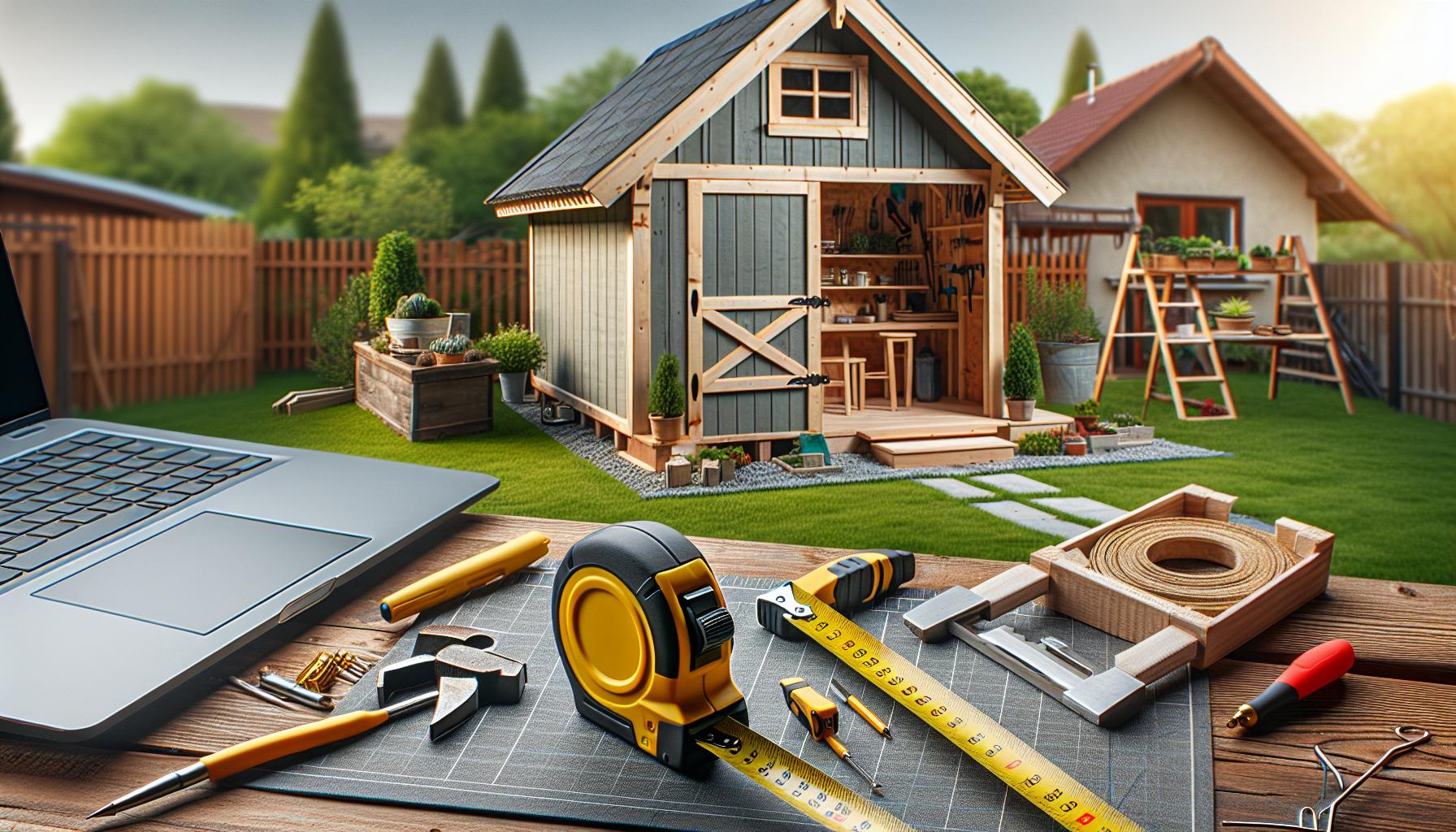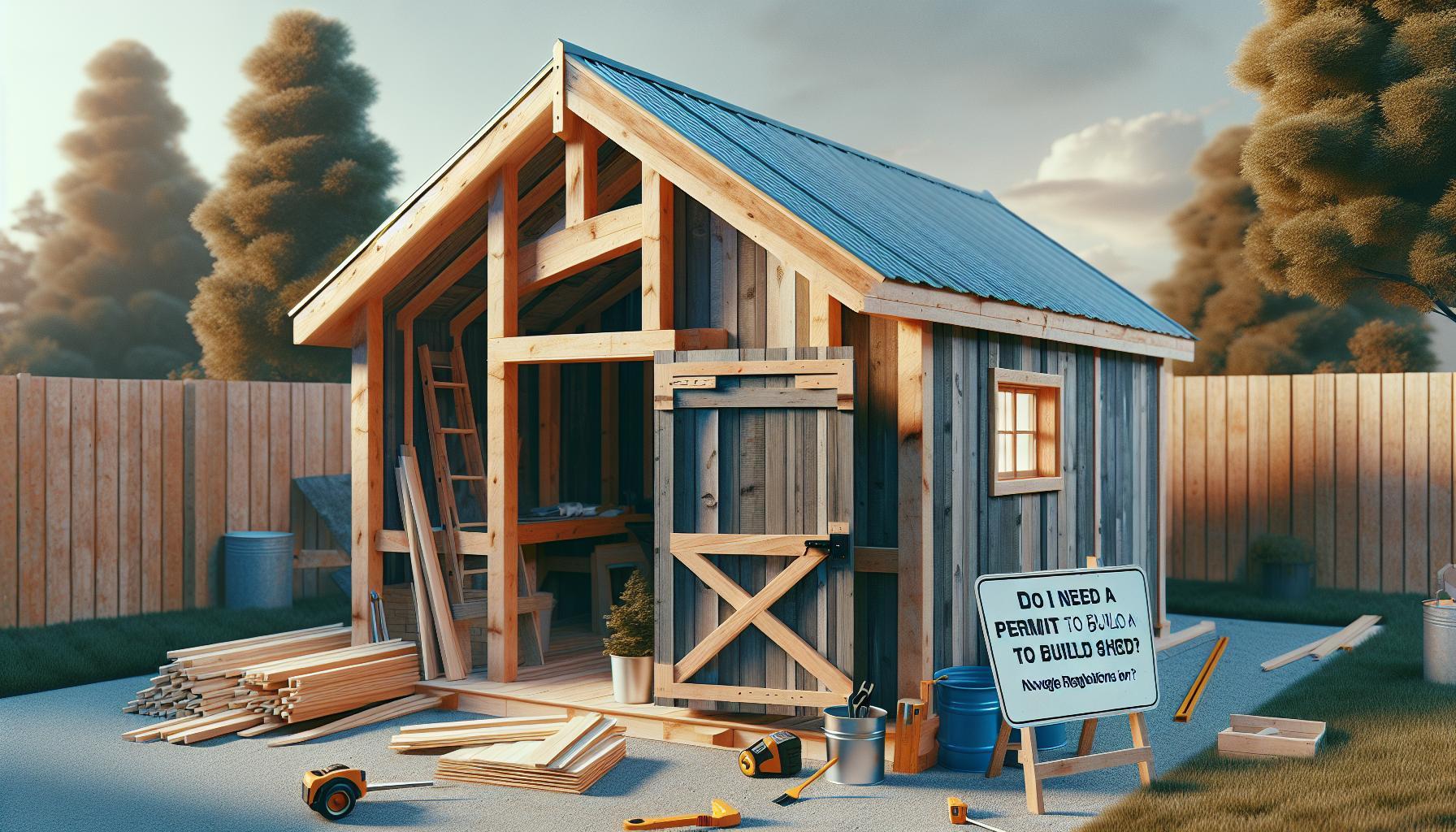Building a shed can be a fantastic way to enhance your outdoor space, but how close can you get to your property line? Knowing the right measurements is crucial to avoid potential disputes with neighbors or violations of local zoning laws. This guide will clarify essential setback requirements and help you navigate your shed placement confidently.
Understanding Zoning regulations: What You Need to Know Before You build
Before embarking on any building project,it’s crucial to grasp the foundational aspects of zoning regulations as they can considerably influence your plans. Zoning laws dictate how property can be used and what structures can be built, ensuring that developments align with community standards, safety, and land use planning. Ignoring these regulations can lead to costly adjustments or even legal action,making it essential to familiarize yourself with them prior to construction.
Understanding Setback Requirements
One of the most critically important elements of zoning regulations pertains to setback requirements, which specify the minimum distance structures must be from property lines. These laws can vary widely based on location and property type, impacting how close to property line you can build a shed. For instance,in some areas,the setback may be as little as three feet,while in more densely populated regions,it could extend to ten feet or more. Always consult your local ordinance for precise measurements.
Here’s a brief overview of common setback requirements you might encounter:
| Property Type | minimum Setback |
|---|---|
| Residential | 5-10 feet |
| Commercial | 10-20 feet |
| Industrial | 15-25 feet |
Understanding these regulations not only helps you plan effectively but also prevents inadvertent violations that can arise from misunderstandings about how close to property line you can build a shed.
Permitting and Local Guidelines
In tandem with setback regulations, it’s vital to check whether you’ll need a permit for your project. Many municipalities require permits for structures above a certain size or those that could impact drainage and neighboring properties. Engaging with your local zoning office early in the process can save you time and resources. They can provide guidance on required paperwork and inspections that ensure compliance with local building codes.
Moreover, consider the character of your neighborhood when designing your shed.Some areas have architectural guidelines that dictate the style and materials you can use.Aligning your project with these preferences not only contributes to community harmony but also increases the likelihood of your permit being approved smoothly.
Ultimately, before you make any commitments regarding how close to property line you can build a shed, conducting thorough research and engaging with local authorities can streamline your building process and set you up for success.
Setback Requirements: How far should Your Shed Be from the Property Line?
When planning to build a shed, understanding the required distance from your property line is crucial. Setback requirements vary significantly by location, impacting both your construction options and compliance with local regulations. Violating these regulations can result in fines or the need for costly adjustments, so knowing how close to the property line you can build a shed is essential for avoiding potential headaches down the road.
Local building codes typically dictate setback distances. These are defined to ensure there is ample space for safety, privacy, and aesthetic uniformity in neighborhoods. Here are some common setback guidelines that homeowners should consider:
- Front Setbacks: This is the distance from the front property line (often facing the street) that your shed must be set back. Many areas require a range of 10 to 30 feet.
- Side setbacks: Generally, the distance from the side property lines can vary from 3 to 10 feet, although some jurisdictions may have more lenient rules.
- Rear Setbacks: Similar to side setbacks, these often require 5 to 10 feet from the rear property line.
Researching Local Regulations
Before proceeding with your shed construction, check with your local building department or zoning office to obtain specific setback requirements for your area. Websites dedicated to local governance or even community forums can provide valuable insights. In addition, homeowner associations (HOAs) may have their own rules, perhaps complicating how close to the property line you can build a shed.
Common Variances and Exceptions
Occasionally, you may find that your planned shed doesn’t meet local setback requirements, but all is not lost. Many jurisdictions allow homeowners to apply for a setback variance under certain conditions. This process typically involves presenting a justification that outlines why your project should be approved despite not meeting standard regulations. Factors like the proximity to existing structures, the size of your lot, and potential impacts on neighbors may influence the outcome.
Ultimately, meticulous planning and informed decisions regarding how far your shed must be from the property line will not only help conform to local laws but also enhance the functionality and longevity of your outdoor space.
Navigating Local Building Codes: Essential Permits and Inspections
Understanding the intricacies of local building codes is crucial for anyone considering construction projects, such as erecting a shed.Building too close to property lines isn’t just a matter of convenience; it can lead to compliance issues that may derail your project. In municipalities across the country,regulations frequently enough dictate not only how close to your property boundary you can build but also the necessary permits and inspections that you must navigate along the way.
Before you start planning your shed, familiarize yourself with your local zoning laws and building codes, which can vary significantly. Most areas require you to obtain a building permit before commencing construction. this process frequently enough involves submitting plans that detail the proposed location and design of the shed, ensuring they meet local standards for safety and aesthetics.
Essential Steps for compliance
To ensure your project progresses smoothly, consider these essential steps:
- Research Local Codes: Start by checking the local government’s website or contacting the planning department to understand regulations regarding structure distances from property lines.
- Obtain Necessary Permits: Apply for a building permit. Be prepared to provide detailed facts, including the dimensions of the shed and its proximity to property lines.
- Schedule Inspections: Some jurisdictions require inspections at various stages of construction. Familiarize yourself with the timeline and requirements for these inspections to avoid project delays.
- Community Considerations: In certain neighborhoods, homeowners association (HOA) rules may further restrict building positions and designs, regardless of city-county regulations.
Calculating the precise distance to your property line is critical. Many local laws may require a minimum setback—frequently ranging from 5 to 10 feet depending on where you live. A miscalculation here can result in costly mistakes, including fines or the inability to complete the project as planned. Always consult official guidelines and possibly seek advice from a local contractor who is familiar with community codes.navigating local building codes effectively is essential for any construction effort, especially when considering how close to property line you can build a shed. By being proactive and well-informed about permits and inspections, you can not only streamline your project but also ensure that your new shed stands the test of time—both structurally and legally.
Neighbor Relations: Communicating with Adjacent Property Owners
Establishing good neighborly relations can be the cornerstone of a harmonious living environment, especially when you’re considering a construction project like a shed. Clear communication can greatly influence how smoothly the building process goes, and it can definately help prevent misunderstandings regarding your property’s boundaries and the specifics of local zoning laws. By following certain practices, you can foster goodwill and cooperation among adjacent property owners while ensuring your project aligns with regulations regarding how close to the property line you can build a shed.
Start with Open Communication
Before you even contemplate the measurements necessary for your shed, initiating a conversation with your neighbors is crucial. Inform them of your plans and the proposed location of the shed. It’s beneficial to explain why you want to build it, how it will enhance your property, and how it won’t negatively impact their enjoyment of their own space.
- Share Plans: Consider sharing architectural drawings or a layout plan that illustrates the intended location.
- Ask for Feedback: Invite their opinions or concerns which can lead to compromise.
- Discuss Benefits: Highlight how the shed might offer aesthetic or practical benefits, such as reduced clutter or improved landscaping.
Understand Local Regulations
Knowledge of local zoning laws and property line regulations is essential to avoid disputes. Each jurisdiction may have different rules on how close to the property line you can build a shed. Engage in a conversation with your neighbors regarding these regulations to ensure openness and show that you are respectful of shared spaces.
| City/County | Minimum Setback from Property Line | Comments |
|---|---|---|
| City A | 5 feet | Requires a permit for structures over 100 square feet. |
| county B | 10 feet | No permits necessary for small sheds under 50 square feet. |
As you navigate these regulations, it’s also smart to offer to keep your neighbors informed about your progress and any inspections that may take place. This not only clarifies what to expect but also reassures them that their own property rights are being respected.
fostering positive neighbor relations through open, respectful communication and adherence to property regulations sets a solid foundation for your shed project. This proactive approach not only eases any tension but can also cultivate friendships that extend well beyond the boundaries of your respective properties.
The Role of Utility Easements: Planning around Hidden Lines
Navigating the complexities of property boundaries can be a daunting task, especially when considering structures like sheds. One critical aspect that often goes overlooked in shed planning is the presence of utility easements. These designated areas can significantly influence not only where you can build but also how you manage land use long-term. Understanding the implications of utility easements is essential, as it protects both your investment and the vital infrastructure that utilities rely on.
Utility Easements Defined
A utility easement is a legal right allowing utility companies to use a specific portion of land for installation and maintenance of their services,such as power lines,water pipes,or telecommunications cables. These easements can be found within residential zones, and it’s important for homeowners to identify their locations to avoid costly mistakes. When contemplating a structure like a shed, knowing the dimensions and restrictions of these easements can prevent potential conflicts with utility services.
- Easement Widths: Typically range from 5 to 30 feet, but this can vary based on local regulations and utility company requirements.
- Easement Locations: Generally delineated in property surveys or deed descriptions; check local records for precise locations.
- Building Restrictions: Structures may not be placed within the easement,and certain activities,like planting trees,could also be restricted.
Strategizing Around Easements
To effectively plan your shed installation, start by obtaining a complete survey of your property. This documentation will not only clarify where your property line lies but also detail any utility easements that may exist. Once you have this information, consider the following actionable steps:
| Action Item | Details |
|---|---|
| Check Utility Maps | Request maps from local utility companies to understand where their lines run. |
| Consult Local Building Codes | Review regulations regarding shed placement in relation to easements to ensure compliance. |
| Consider Alternative Locations | If easements seem restrictive, explore moving the shed to a different area on your property that complies with all regulations. |
| Communicate with Neighbors | Talk to adjacent property owners to confirm utility line locations, as shared easements may affect your planning. |
By proactively addressing utility easements during the planning phase, you not only ensure compliance with local laws but also contribute to the safety and reliability of community infrastructure. Keeping these essentials in mind while considering how close to the property line you can build a shed will lead to a more triumphant, conflict-free construction experience.
How to Measure Your Property Lines Accurately for Shed Placement
When it comes to placing a shed on your property, understanding the precise location relative to your property lines is crucial. Not only does it ensure compliance with local regulations regarding the placement of structures, but it also helps avoid future disputes with neighbors. Before you grab your tools and start digging, a thorough measurement process is essential.
Gather Necessary Tools
To measure your property lines accurately, you need a few essential tools:
- Measuring Tape: A long measuring tape (at least 100 feet) is ideal for large yard measurements.
- Surveyor’s Flags: Use these for marking the corners of your property.
- Compass or Smartphone App: A compass or mapping app can help you confirm your property’s orientation.
- Notebook or App for Recording Measurements: Maintain a clear record of your measurements for future reference.
Locate Your Property corners
Finding the exact corners of your property is the first step in measuring your property lines. If you have access to a property survey,refer to it,as surveys often include detailed descriptions of property boundaries. If a survey is not available, you can typically find the property pins—metal stakes that denote corners—by checking with your local planning department or hiring a professional land surveyor.
Measure Your Property Lines
Once you have marked your corners, it’s time to measure the distance along your property lines. Here’s a straightforward approach to doing this:
- From Corner to Corner: Starting at one property corner, measure the distance to the next corner. Note these measurements down.
- Check for Right Angles: Most properties have right angles. You can use the 3-4-5 triangle method (3 feet along one side, 4 feet along the other, and the hypotenuse should be 5 feet) to ensure your angles are correct.
- Document Your Findings: Keep a note of all measurements and any peculiarities in the layout, like fences or trees that could potentially affect your shed placement.
Now that you have accurate measurements of your property, assess how close to the property line you can build your shed. This varies by local regulations,which might be shaped by zoning laws or neighborhood association rules.
| Zone | Minimum Distance from Property Line |
|---|---|
| Residential | 5-10 feet |
| Commercial | 10-20 feet |
| Agricultural | 10 feet |
consult Local Regulations
Consulting local zoning regulations is the final step. Official guidelines will define exactly how close to property lines you may place your shed. You can usually find this information on your local government’s website or by directly contacting the planning or zoning department. Remember, taking the time to measure accurately and verify your property lines can save you headaches in the future due to potential disputes or necessary relocations.
creative Shed Solutions: Designing Within Limitations
When it comes to creating your ideal outdoor space, designing a shed can seem daunting, especially when you have to work within the constraints of property lines. Understanding the regulations regarding how close to the property line you can build a shed is not just a matter of legal compliance; it’s also an possibility to get creative with your design. Maximizing your limited space while ensuring aesthetic appeal and functionality can turn the limitations into unique design features.
Leveraging Space Constraints
Many homeowners find themselves in a position where property line setbacks dictate the dimensions and placement of their sheds. This necessity can spur innovation, leading to the creation of structures that might actually be more visually appealing and functional than those that could be placed without restriction. Here are some creative design elements to consider:
- Vertical building: If you’re restricted in width, think about building upwards. A compact,two-story shed can provide extra storage without taking up valuable yard space.
- Multi-Functional designs: Consider incorporating areas for gardening tools, a small workshop, or even a potting station. This makes better use of confined spaces.
- Natural Barriers: Use landscaping—like hedges or posts—as part of your shed’s exterior. This adds depth and beauty without positioning your structure too close to property lines.
Incorporating Aesthetic features
Strategically positioning your shed can enhance your overall landscaping design while adhering to regulations concerning how close to the property line you can build. Adding visual elements such as windows, trellises, or even a green roof can make even the smallest sheds feel integrated into your yard. Here are some ways to incorporate aesthetic features effectively:
- Choose Compatible Colors: Paint your shed in colors that coordinate with your home’s exterior to create harmony across your property.
- Use Natural Materials: Consider wood or stone siding to help the shed blend into the natural surroundings, softening the impact of its size.
- Designing Pathways: Create pathways leading to your shed that use landscaping elements like stones or mulch,drawing the eye away from the constraints imposed by property lines.
Planning for Functionality
Before embarking on your project,ensure you understand the specific regulations that apply to your area. Different municipalities have varying codes regarding how close to property line you can build a shed. Having this knowledge allows for more informed design decisions. Here’s a simple table to keep track of essential measurements:
| Region | Setback Requirement (ft) |
|---|---|
| Urban | 5-10 |
| Suburban | 10-15 |
| Rural | 15-20 |
By taking the time to understand local regulations and employing thoughtful design strategies, you can create a shed that complements your yard and meets all necessary guidelines. Embrace the restrictions as a chance to innovate and functionally enhance your space. Whether you are maximizing vertical space or blending your shed with your landscape, there’s a world of creativity waiting to be explored.
Tips for Avoiding common Sheds and Property Line Mistakes
When planning to build a shed, knowing how close to the property line you can go is just the begining. Many shed owners encounter preventable issues that can lead to costly mistakes or disputes with neighbors. Understanding the common pitfalls can save time, money, and headaches in the long run.
Know Your Property Lines
Before you even think about laying a foundation, the first step is to accurately determine where your property lines are located. This is more than just eyeballing it; consider the following strategies:
- Consult Your Property Deed: Frequently enough, your property’s deed will provide clear dimensions and boundaries.
- Use a Surveyor: A professional surveyor can provide precise measurements and even mark boundaries, which may be especially helpful for larger or oddly shaped lots.
- Talk to Neighbors: Sometimes, your neighbors might have insights or documents regarding the exact property lines, which can help you obtain a clearer picture.
Understand local Regulations
Each municipality may have different regulations governing how close structures can be built to property lines. To avoid any missteps,take the following steps:
- Check Local Zoning Laws: Visit your city or county’s website or planning department to find zoning codes that pertain to shed construction.
- Obtain Necessary Permits: In many areas, specific permits are needed for building any structure on your property. Failing to acquire the correct documentation can lead to fines or orders to remove your shed.
- Review HOA Rules: If you live in a community governed by a Homeowners Association (HOA), their rules may be even more restrictive than local laws.
Create a Detailed plan
once you have a clear understanding of your property lines and local regulations, the next step is to draft detailed plans for your shed:
- Measure and Mark: use tapes or stakes to mark where the shed will stand in relation to the property line. Double-check the distances to avoid any surprises.
- Incorporate Setback Requirements: Many jurisdictions require a certain distance (setback) from the property line. Ensure your design follows these parameters.
- Consult a Legal Expert: If you’re unsure about legal implications, a brief consultation with a real estate attorney can definitely help clarify your rights and responsibilities regarding property lines.
| Potential Mistake | Consequence | Preventive measure |
|---|---|---|
| Building too close to the property line | possible removal of the shed | Check local zoning laws and obtain a survey |
| Ignoring HOA rules | Fines or forced removal | Review HOA regulations before planning |
| Improper drainage | Water damage or flooding | Plan for proper water runoff |
Avoiding these common mistakes can help ensure your shed will serve its purpose without complications from neighbors or local authorities. By taking the time to understand your property and local regulations, you set yourself up for a successful building project.
Faq
How Close to Property Line Can You Build a Shed?
The distance you can build a shed from your property line typically ranges from 3 to 10 feet,depending on local zoning regulations. Always check your municipality’s building codes and setbacks for specific requirements.
setbacks are the required distances from the property line to the building, and they vary by location and type of structure. Many areas have strict rules regarding how close structures can be to property lines to ensure safety and privacy. For detailed guidelines, you may refer to your local zoning laws or visit your local government’s website.
What is a property line and why is it important for shed construction?
A property line defines the boundaries of a property and indicates where your land ends and your neighbor’s begins. Understanding this boundary is crucial to avoid legal disputes when building a shed.
Constructing too close to a property line may result in fines or the need to relocate the shed if it’s deemed non-compliant. Therefore, it’s essential to mark your property line accurately and observe all local building codes to ensure your shed is legally and safely positioned.
Can I build a shed on a property line?
no, you generally cannot build a shed directly on a property line as it usually violates local zoning laws. Most areas require a certain setback distance.
Building on or near the property line can lead to disputes or necessitate the removal of your shed. To avoid these complications, it’s wise to consult your local building authority or a qualified contractor to ensure compliance with all regulations.
Why do different cities have varying rules for setbacks?
Different cities establish varying setback regulations based on local aesthetics, safety, public health, and historical context. Local officials consider factors like land use, population density, and development patterns when creating these rules.
This means that what might potentially be allowed in one jurisdiction could be prohibited in another.Always check with your city’s zoning department to understand the specific rules applicable to your area to avoid surprises during your project.
How can I measure my property line accurately?
You can measure your property line accurately by using a property survey or by utilizing tools like a measuring tape and compass. Obtaining a property survey from a licensed surveyor provides precise boundary lines.
If a survey isn’t available, locate any markers that were placed during the property’s purchase. Mark the line using stakes and string for visual guidance as you plan your shed placement to ensure adherence to setback requirements.
Can a neighbor’s property line affect my shed construction?
yes, a neighbor’s property line can significantly impact your shed construction. You must maintain the required distance from that line to comply with local zoning laws.
If your shed is too close, your neighbor could object, leading to disputes.It’s essential to communicate with your neighbors before starting your project and ensure all setbacks are respected to maintain good relationships and avoid legal issues.
where can I find more information regarding local zoning laws for building a shed?
you can find local zoning laws regarding shed construction on your city or county’s official website. Most municipalities have a zoning department that can provide guidelines.
Additionally, consider visiting community forums or speaking with local builders who are familiar with regulations in your area. For more detailed information on planning your shed, visit our article on how to construct a shed legally.
Wrapping Up
knowing how close to your property line you can build a shed is essential for a successful and worry-free construction project.By understanding local zoning regulations, setback requirements, and the importance of proper measurement, you can embark on this DIY journey with confidence. Remember to check with your local building department, as community rules may vary, ensuring you’re on the right track from the start.
By planning carefully and adhering to these guidelines, you can create a lovely and functional addition to your outdoor space that enhances both your property and your lifestyle.Embrace the challenge and don’t hesitate to reach out for further resources or guidance as you turn your shed-building dreams into reality. Happy crafting, and may your projects bring you joy and satisfaction as you work towards creating the perfect shed tailored to your needs!







